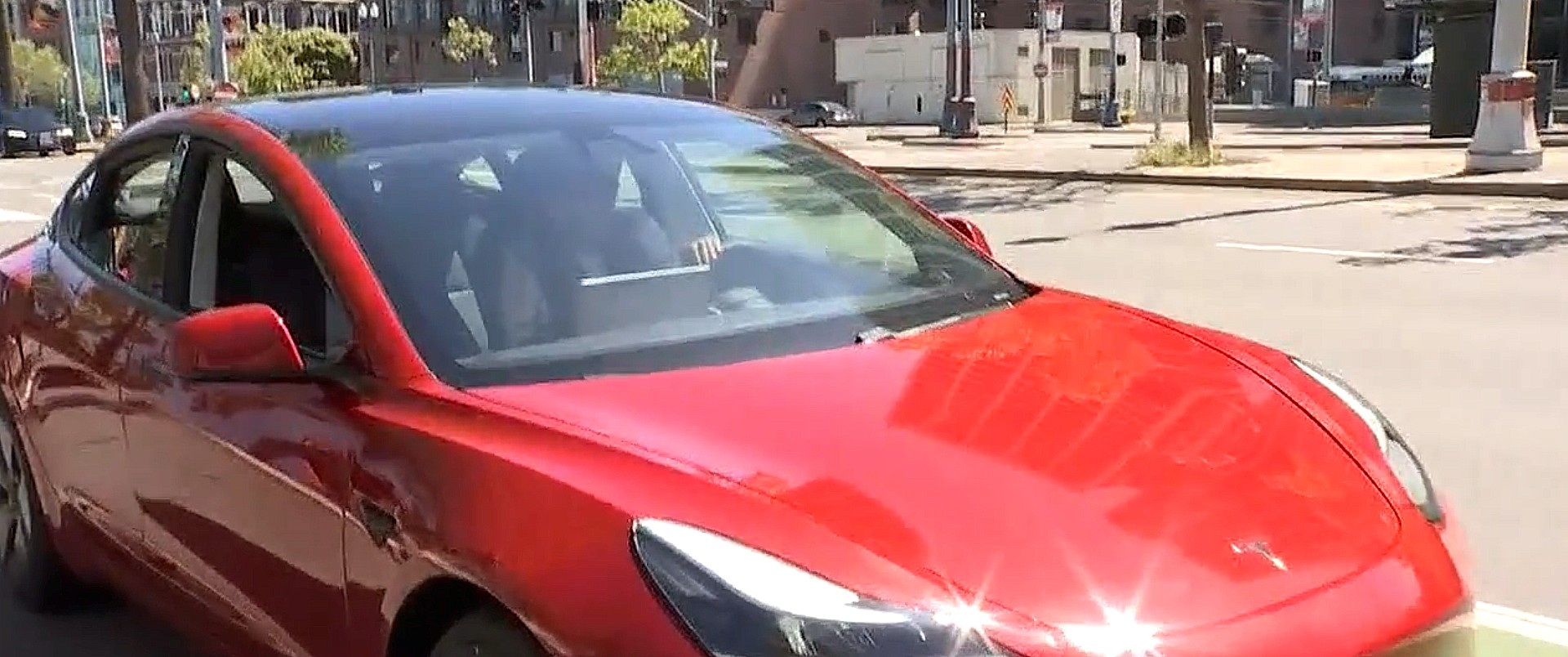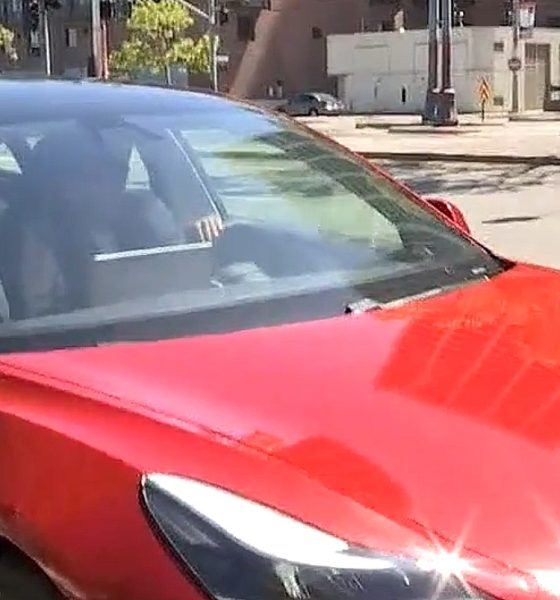

News
Tesla Autopilot abuser released from jail, buys new Tesla, rides in backseat again
The Tesla Autopilot abuser arrested earlier this week for reckless driving after riding in the back seat of his electric car while operating on Autopilot is out of jail. Now, he is in a new Model 3 and riding around in the backseat once again after claiming that he’s so rich, he can buy a new Tesla every time the police arrest and release him from jail.
“I’m rich as (expletive). I’m very rich,” 25-year old Param Sharma said to San Francisco’s KTVU on Wednesday. “I’ll just get a new Tesla every time. I have unlimited money to blow on Teslas. If you take my Tesla away, I will get another Tesla.”
Sharma was arrested on Monday after a video of him riding in his all-electric Tesla in the backseat on Interstate 80 surfaced online. It was his second arrest in two months.
UPDATE 1/2: Param Sharma tells @JesseKTVU he already got a bright-red brand-new @Tesla Model 3 after @CHPoakland towed his other one because of his backseat driving pic.twitter.com/H5Ning2leP
— Henry K. Lee (@henrykleeKTVU) May 13, 2021
After his arrest on Monday, Sharma was charged with two counts of reckless driving and disobeying a police officer. He was subsequently released, and legal analysts believe that the Judge will warn him of further consequences if his actions persist.
“What I think you’ll see is his first court date is the judge give him a very stern warning and say, ‘You are not to drive unless you’re in the driver’s seat of your vehicle. And if you do, we’re gonna put you back in jail,’” Steven Clark, a Santa Clara County-based legal analyst, told KTVU. Sharma isn’t bothered because he says every time he’s arrested and released, he’ll just buy a new car.
Tesla owner arrested due to Autopilot abuse pledges to continue Autopilot abuse
The risks of driving a Tesla on Autopilot without actually operating the vehicle are tremendous and provide numerous issues for various people. First, the operator of the car is misusing Autopilot. Tesla does not have a Level 5 Autonomous driving program, nor has it ever claimed that its vehicles could be driven without supervision from the driver. To this day, the company’s website still indicates that drivers must remain attentive and keep their hands on the steering wheel at all times.
The company’s Autopilot Frequently Asked Questions page states:
“Yes. Autopilot is a hands-on driver assistance system that is intended to be used only with a fully attentive driver. It does not turn a Tesla into a self-driving car nor does it make a car autonomous.
Before enabling Autopilot, you must agree to “keep your hands on the steering wheel at all times” and to always “maintain control and responsibility for your car.” Once engaged, if insufficient torque is applied, Autopilot will also deliver an escalating series of visual and audio warnings, reminding you to place your hands on the wheel if insufficient torque is applied.”
Additionally, the misuse of Autopilot is dangerous to other drivers, pedestrians, and anyone near a public roadway. The vehicle is still to be controlled and supervised by the driver, and Autopilot is not capable of traveling on streets without an attentive driver.
Finally, it is a huge risk for Tesla and other companies attempting to solve fully autonomous driving or even semi-autonomous driving. An incident that occurs due to a lapse in supervision or responsibility by the driver could result in major steps back in the pursuit of autonomy. While regulations in the United States and other countries are already stringent, irresponsible use of any semi-autonomous driving functionality could lead to even more delays in legislation or regulations that ease the restrictions on assisted driving.
Sharma will appear in court on July 6th, and he said he will plead not guilty.

News
Tesla FSD fleet is nearing 7 billion total miles, including 2.5 billion city miles
As can be seen on Tesla’s official FSD webpage, vehicles equipped with the system have now navigated over 6.99 billion miles.

Tesla’s Full Self-Driving (Supervised) fleet is closing in on almost 7 billion total miles driven, as per data posted by the company on its official FSD webpage.
These figures hint at the massive scale of data fueling Tesla’s rapid FSD improvements, which have been quite notable as of late.
FSD mileage milestones
As can be seen on Tesla’s official FSD webpage, vehicles equipped with the system have now navigated over 6.99 billion miles. Tesla owner and avid FSD tester Whole Mars Catalog also shared a screenshot indicating that from the nearly 7 billion miles traveled by the FSD fleet, more than 2.5 billion miles were driven inside cities.
City miles are particularly valuable for complex urban scenarios like unprotected turns, pedestrian interactions, and traffic lights. This is also the difference-maker for FSD, as only complex solutions, such as Waymo’s self-driving taxis, operate similarly on inner-city streets. And even then, incidents such as the San Francisco blackouts have proven challenging for sensor-rich vehicles like Waymos.
Tesla’s data edge
Tesla has a number of advantages in the autonomous vehicle sector, one of which is the size of its fleet and the number of vehicles training FSD on real-world roads. Tesla’s nearly 7 billion FSD miles then allow the company to roll out updates that make its vehicles behave like they are being driven by experienced drivers, even if they are operating on their own.
So notable are Tesla’s improvements to FSD that NVIDIA Director of Robotics Jim Fan, after experiencing FSD v14, noted that the system is the first AI that passes what he described as a “Physical Turing Test.”
“Despite knowing exactly how robot learning works, I still find it magical watching the steering wheel turn by itself. First it feels surreal, next it becomes routine. Then, like the smartphone, taking it away actively hurts. This is how humanity gets rewired and glued to god-like technologies,” Fan wrote in a post on X.
News
Tesla starts showing how FSD will change lives in Europe
Local officials tested the system on narrow country roads and were impressed by FSD’s smooth, human-like driving, with some calling the service a game-changer for everyday life in areas that are far from urban centers.

Tesla has launched Europe’s first public shuttle service using Full Self-Driving (Supervised) in the rural Eifelkreis Bitburg-Prüm region of Germany, demonstrating how the technology can restore independence and mobility for people who struggle with limited transport options.
Local officials tested the system on narrow country roads and were impressed by FSD’s smooth, human-like driving, with some calling the service a game-changer for everyday life in areas that are far from urban centers.
Officials see real impact on rural residents
Arzfeld Mayor Johannes Kuhl and District Administrator Andreas Kruppert personally tested the Tesla shuttle service. This allowed them to see just how well FSD navigated winding lanes and rural roads confidently. Kruppert said, “Autonomous driving sounds like science fiction to many, but we simply see here that it works totally well in rural regions too.” Kuhl, for his part, also noted that FSD “feels like a very experienced driver.”
The pilot complements the area’s “Citizen Bus” program, which provides on-demand rides for elderly residents who can no longer drive themselves. Tesla Europe shared a video of a demonstration of the service, highlighting how FSD gives people their freedom back, even in places where public transport is not as prevalent.
What the Ministry for Economic Affairs and Transport says
Rhineland-Palatinate’s Minister Daniela Schmitt supported the project, praising the collaboration that made this “first of its kind in Europe” possible. As per the ministry, the rural rollout for the service shows FSD’s potential beyond major cities, and it delivers tangible benefits like grocery runs, doctor visits, and social connections for isolated residents.
“Reliable and flexible mobility is especially vital in rural areas. With the launch of a shuttle service using self-driving vehicles (FSD supervised) by Tesla in the Eifelkreis Bitburg-Prüm, an innovative pilot project is now getting underway that complements local community bus services. It is the first project of its kind in Europe.
“The result is a real gain for rural mobility: greater accessibility, more flexibility and tangible benefits for everyday life. A strong signal for innovation, cooperation and future-oriented mobility beyond urban centers,” the ministry wrote in a LinkedIn post.
News
Tesla China quietly posts Robotaxi-related job listing
Tesla China is currently seeking a Low Voltage Electrical Engineer to work on circuit board design for the company’s autonomous vehicles.

Tesla has posted a new job listing in Shanghai explicitly tied to its Robotaxi program, fueling speculation that the company is preparing to launch its dedicated autonomous ride-hailing service in China.
As noted in the listing, Tesla China is currently seeking a Low Voltage Electrical Engineer to work on circuit board design for the company’s autonomous vehicles.
Robotaxi-specific role
The listing, which was shared on social media platform X by industry watcher @tslaming, suggested that Tesla China is looking to fill the role urgently. The job listing itself specifically mentions that the person hired for the role will be working on the Low Voltage Hardware team, which would design the circuit boards that would serve as the nervous system of the Robotaxi.
Key tasks for the role, as indicated in the job listing, include collaboration with PCB layout, firmware, mechanical, program management, and validation teams, among other responsibilities. The role is based in Shanghai.
China Robotaxi launch
China represents a massive potential market for robotaxis, with its dense urban centers and supportive policies in select cities. Tesla has limited permission to roll out FSD in the country, though despite this, its vehicles have been hailed as among the best in the market when it comes to autonomous features. So far, at least, it appears that China supports Tesla’s FSD and Robotaxi rollout.
This was hinted at in November, when Tesla brought the Cybercab to the 8th China International Import Expo (CIIE) in Shanghai, marking the first time that the autonomous two-seater was brought to the Asia-Pacific region. The vehicle, despite not having a release date in China, received a significant amount of interest among the event’s attendees.








